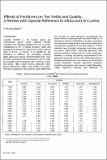| dc.description.abstract | Introduction the increase in world demand, consequently tea Camellia sinensis L. 0 . Kuntze plants are commercially grown under different climatic conditions with latitudes ranging from 49' N (Outer Carpathians) to 33' S (Natal) (Shoubo, 1989) and altitudes from sea level in Japan and Turkey to above 2500 m a.m.s.l. in Kenya. It is planted for the production of different tea beverages including green, black and various semi-fermented teas. Over the years, production has continued to rise. In, 1980 for example world production was 1,848,016 metric tons (Anon, 1981), which rose to 2,962,590 metric tons in 1985 (Anon, 1999), a rise of 60% in 16 years. The rise in production has however, been faster than the increase in world demand, consequently tea prices have not improved with time (see Table 1). In attempts to improve profitability or to stay in business most producers have tried to use various methods to increase the quantities of tea they produce. These methods have included increasing land area under tea (Anon, 1996) and/or improving agronomic and cultural practices. Further land for more production, however, is running out leaving improvement of the agronomic practices as the most viable alternative to increase productivity per unit amount of input hence overall production. | en_US |

